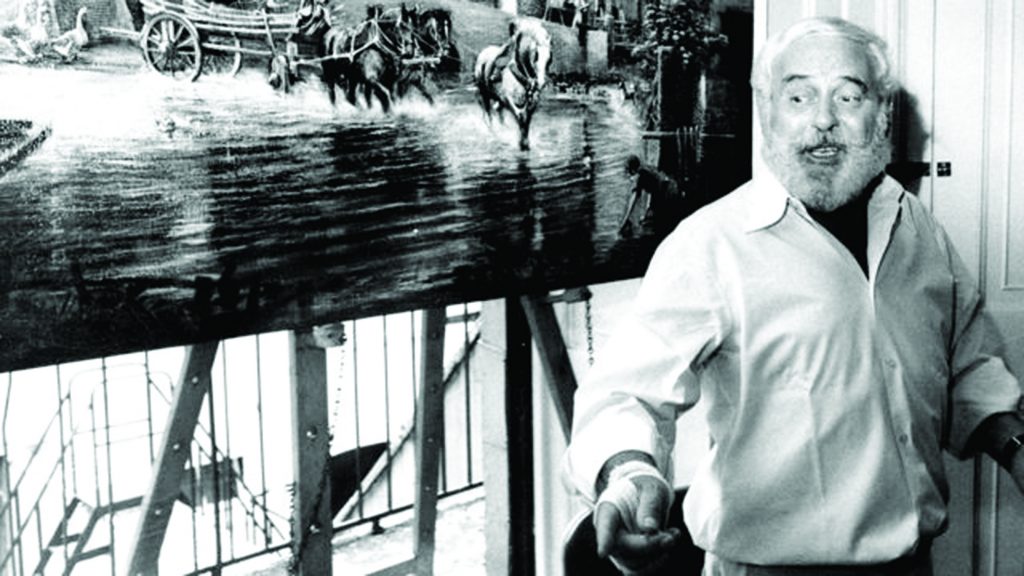Fakes & Fakery
Tom Keating: The Cheerful Charlatan
In June 1977, a book entitled The Fake’s Progress was published by Hutchinson’s in the UK. It became an immediate best-seller, while creating a controversial stir and blowing the gaffe on art dealers.
This boisterous and breezy publication also carried one of the longest sub-titles ever to appear in print. It reads: Being the cautionary history of the Master Painter and Simulator Mr Tom Keating, as recounted with the utmost candour, without fear or favour to Mr Frank Norman, together with a dissertation upon the traffic in works of art by Mrs Geraldine Norman.

In the annals of forgery, Tom Keating’s story is remarkable because he did not produce fakes for money but to show up the art world, against which he bore a long grudge.
At infant school, his only interest was art. He passed an entrance examination for St Dunstan’s College but his parents could not afford the money for books and clothes, so he worked at odd jobs, attending evening classes at Camberwell College of Art and reading avidly in an attempt to make up for his lost school education.
In 1948, following his conscription as a naval stoker during WWII, Keating was awarded an art rehabilitation course at Goldsmith’s College. In the evenings and at the weekends he worked as a handyman. He was obsessed with becoming a great and recognised painter and during this time he also supplemented his income by restoring old paintings brought to him by seedy art dealers in Soho.
He failed twice to gain the National Diploma at Goldsmith’s College and this infuriated him and made him more determined to get his own back on the art establishment. He became known as a competent painter and restorer who harboured a chip on his shoulder against the art world.
In the early 1950s, he bought a van-load of old canvases and frames to work on. He began by concentrating on 17th-century Dutch masters such as Brouwer, Gabriel Metsu and Pieter de Hoogh, which he would sell for very little money to local residents or visitors to his studio.
During the 1950s and 1960s, as the occasion arose, he imitated almost all the major 18th and 19th-century English artists, including Constable, Gainsborough and Turner; the old masters of the Dutch school, especially Rembrandt; the Spanish Francesco Goya; the Venetian Francesco Guardi and, last but not least, the French impressionists Degas, Manet, Renoir, Alfred Sisley and many others.
Keating’s undoing began after he read the book Valley of Vision by Geoffrey Grigson, about the life of the little-known 19th-century visionary artist Samuel Palmer. At the age of 15, Palmer had already had an impact on the art scene. He was living in Shoreham, Kent, and his landscape watercolours demonstrated an intensely mystical and visionary style which brought him instant fame. However, by the time he was 30, his ecstatic muse deserted him and Tom Keating was delighted to imaginatively step in and fill in some of the void created by Palmer’s block.
Geraldine Norman was writing for The Times when she began to suspect the flood of Palmer paintings that suddenly materialised in auction catalogues. She started to investigate and, on 16 July 1976, published her first piece, suggesting that 13 Palmers were, in all probability, fakes. On learning that the main suspect had moved to a rented cottage on the outskirts of the village of Dedham in Kent, she visited Keating who talked freely about his life and work but sidestepped all questions about Palmer. On 10 August 1976, Geraldine published her second article, naming Tom Keating as the probable forger.
Instead of making himself scarce, Keating phoned Geraldine and she met him, along with her writer husband, Frank. They agreed to publish a book about the Palmer affair to be ghost-written by Frank Norman.

Tom Keating’s published revelations created an embarrassing situation for the art dealers and connoisseurs, especially after the BBC produced a documentary entitled A Picture of Tom Keating. By this time, Scotland Yard was on hot his trail.
Summoned to court in January 1979, Keating conducted his own defence and used every opportunity to air his pet bug-bears and castigate the art world. The prospect of a long jail sentence loomed large, but providence intervened.
While returning to Dedham for the weekend on his motorbike, Keating skidded and broke his leg in the subsequent fall. Immediately after the accident he developed bronchitis which accentuated some severe heart problems. The prosecution withdrew its case, and the Judge entered a ruling of nolle prosequi – which means neither guilty nor not guilty.
After the aborted trial, many opportunities arose – amongst them the 1982 BBC Channel Four’s serial screening of Tom Keating on Painters. This proved to be a riveting series and Keating emerged as a great teacher and a television natural. A year later, it was followed by another television series entitled Tom Keating on Impressionism.
The man who confessed to some 2,000 forgeries, in the styles of 121 individual artists, died in February 1984. The painter Leo Stevenson called him ‘the cheerful charlatan who made art wildly popular on TV’.








